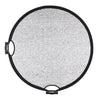HSS, Duration, Recycle Times and Burst Mode: Flash Technologies
It can be difficult to get to grips with the different flash features such as high speed sync (HSS), flash recycle times, flash duration and high-speed continuous shooting on your camera and lights. Here's a summary of four of the most crucial flash features you can employ and how they work, if you're having trouble getting your settings and features to create the pictures you're envisioning.
Flash Recycle Time
Recycle time is the amount of time it takes for a digital camera flash to reset between photos. A shorter recycle time means you can take more shots in rapid succession. It can be useful if you're photographing fast-moving subjects or want to ensure you catch the decisive moment in a portrait session.

Recycle time is a crucial factor to consider when choosing a flash unit. A long recycle time translates to longer waiting times between two consecutive flashes. This is not ideal when you're striving for rapid-fire shots. On the other hand, a fast recycle time empowers photographers to capture moment without being constrained by waiting times. It ensures you never miss capturing that perfect shot. If you're aiming to synchronize your flash with high-speed continuous shooting, a flash unit with short recycle time is your go-to solution.
High Speed Sync
High Speed Sync (HSS) is a feature in modern camera systems that allows photographers to use flash at shutter speeds faster than the camera's maximum sync speed. It is typically around 1/200 to 1/250 seconds. This feature is particularly useful when you want to balance ambient light and flash lighting in situations where you need to use a wide aperture or a fast shutter speed.

Related Articles: True High-Speed Sync vs Long Tail High-Speed Sync, Can You Use HSS to Freeze Motion?
When your camera's shutter speed exceeds the flash sync speed, the curtain movement changes. It's like a seamless scan, with the curtains never fully opening at any point. If your flash fires only once during this time, you may end up with unsynchronised lighting with dark edges and off shadows. With HSS, your flash co-operated flawlessly with high shutter speeds. It ensures every nook and cranny of curtain movement is illuminated, resulting in stunning picture-perfect shots.
High-Speed Continuous Shooting
High-speed continuous shooting is a setting on a camera that allows you to take multiple images at once. When you intend to use a flash in conjunction with high-speed continuous shooting, there are important considerations to keep in mind.
Flash Power: Avoid setting the flash power too high. You need to consider the flash's recycle time. If the flash power is too high and the recycle speed is slow, the flash might not keep up with the camera's continuous shooting speed.
Avoid Using TTL: In TTL mode, a pre-flash for metering is fired before each main flash, which can slightly delay the recycling process. Additionally, in TTL mode, it is challenging to predict the flash power precisely. If the power is set too high and the recycle speed is slow, is may lead to situations where the continuous shooting speed exceeds the flash capacity, resulting in missed flashes.
Disable HSS During High-Speed Continuous Shooting: If the high-speed sync function of the flash is activated, it theoretically involves rapid flashing. It can cause the flash to overheat, potentially leading to not being able to sustain the continuous shooting.
See Related: High Speed Sync Troubleshooting: Why Do My Photos Look So Dark? with Jason Vaughan
Flash Duration
Flash duration is the length of time that a flash emits light during a single burst. The shorter the flash duration, the better it is for freezing motion and capturing sharp details, such as motion in dance or sport, moving water droplets, or explosions. It is a shown as one of two measurements: t0.5 or t0.1.

The t0.5 value is the time it takes for 50% of the light to dissipate. This duration is termed the "Effective Flash Duration".
The t0.1 value is the time it takes for 90% of the power from the flash tube to dissipate. This is known as the "Total Flash Duration".
Comparing these two, t0.5 has a significant gap from the t0.1 Total Duration. This makes the t0.1 value more meaningful as a reference point.
Conditions for freezing motion include: A sufficiently fast shutter speed, and a relatively dark shooting environment.
Still need some assistance with the features on your flash, or when looking to purchase your first flash units? Our Technical Team can help out! Just drop us an email at info@essentialphoto.co.uk.









































































































































































































































































.png?v=1684398018113)














